So, you’re a fitness trainer, and you’re thinking about selling your fitness programs online. But you’re not sure if you should take the leap.
Is the market big enough?
Is there room for you to build a successful business?
And how do you get started?
Well, here’s a stat that might excite you.
The online fitness market is booming. In 2023, it was valued at $15.3 billion, and by 2032, it’s expected to explode to $186.1 billion, growing at a whopping 32% per year.
Fitness creators teaching yoga online go on to earn an average of $7,500 a month, and we’re seeing that number continue to grow.
Like Brook Cates, founder of The Bloom Method. She makes $1m in annual revenue from her fitness membership business.
So yes. There’s definitely room for you.
But like any industry, selling fitness programs online—and doing it successfully—means you’ve got to stand out.
And that’s exactly what this Ultimate Guide is all about.
I’ll walk you through how to:
- Define your audience – Who they are, what they need, and how to attract them.
- Analyze your competitors – See what’s working and how you can do it better.
- Create your signature fitness program – One that people actually want to buy.
- Position your fitness brand – Stand out from the crowd and become the go-to expert.
- Choose the right business model – And the one strategy that will help you sell workout plans online and build a successful, sustainable online fitness business.
- Create a high-converting sales machine – A website and marketing system that sells fitness programs 24/7 while you focus on training.
Much of this work will require some effort, and to streamline your workload, I’ll share how to use AI to get answers–fast!
I’ll also share examples of creators selling fitness programs online along the way, more proof that this is something you can do.
And if all of this sounds a little overwhelming, I’ve also broken down the entire process into a simple and easy-to-execute 7-day project.
Note: This doesn’t include time set aside to create video content for fitness programs you’ll sell online. The speed at which you create content depends on your skill level and the tools you have.
This guide will, however, walk you through figuring out what you’ll need to film once you’ve identified who to sell to and what they want.
Ready?
Let’s dive in!
Day 1: Market Research – Figure Out Your Audience
Before you start creating and selling fitness programs online, you need to understand who you’re serving and what you’re up against.
Market research helps you answer two key questions:
- Who is your ideal customer? (a.k.a. your target audience)
- Who else is selling similar programs? (your competitors)
The good news?
You can gather a ton of this information online for free. Let’s break it down step by step.
Finding Your Audience
One of fitness creators’ biggest mistakes is trying to market to everyone. Saying “I help people lose weight” is too broad.
The more specific you get, the easier it is to attract the right people and stand out in the crowded online fitness space.
Here’s why:
- Better marketing: You can craft content that speaks directly to their pain points.
- Stronger retention: A program tailored to a specific group keeps people engaged.
- Higher sales conversion: When people feel like your program was made for them, they’re more likely to buy.
Pilates for Runners is a great example: it’s clear who this program is for right off the bat.
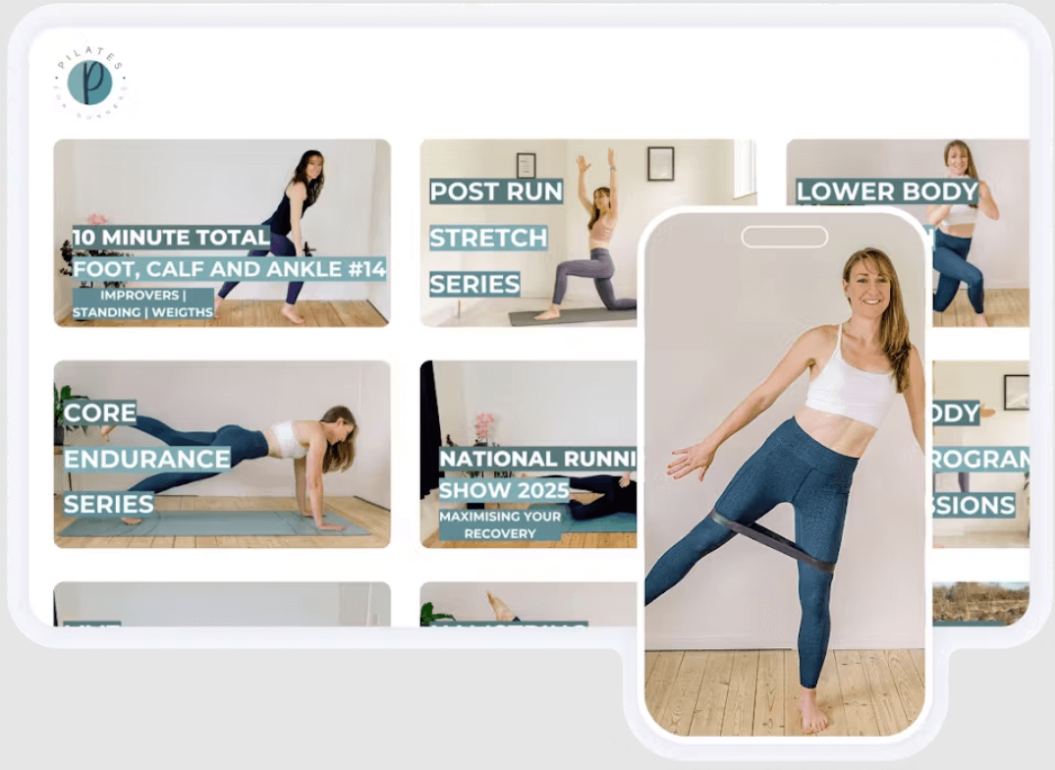
Step 1: Choose Your Core Focus
Start by deciding what type of fitness solution you’re offering. Are you helping people:
- Lose weight?
- Build muscle?
- Improve flexibility?
- Gain endurance?
- Focus on mindset and mental wellness?
Step 2: Define Your Ideal Customer
Now, break down your audience by answering these questions:
- Who is your target audience? (Age, gender, lifestyle, job, income level)
- What is their biggest struggle? (No time? Lack of motivation? Inconsistent results?)
- What have they already tried? (Gyms, diet plans, fitness apps, personal trainers?)
- What motivates them? (Confidence, aesthetics, energy, stress relief?)
- Where do they consume fitness content? (Instagram, YouTube, fitness blogs, podcasts?)
Step 3: Research Your Audience
To confirm your assumptions, use real audience data from:
- Google Trends – See what fitness topics are trending.
- AnswerThePublic – Discover the most common questions people ask about your niche.
- Reddit & Quora – Read real discussions about fitness struggles.
- YouTube Comments & Amazon Reviews – Check fitness programs, books, or apps for common feedback.
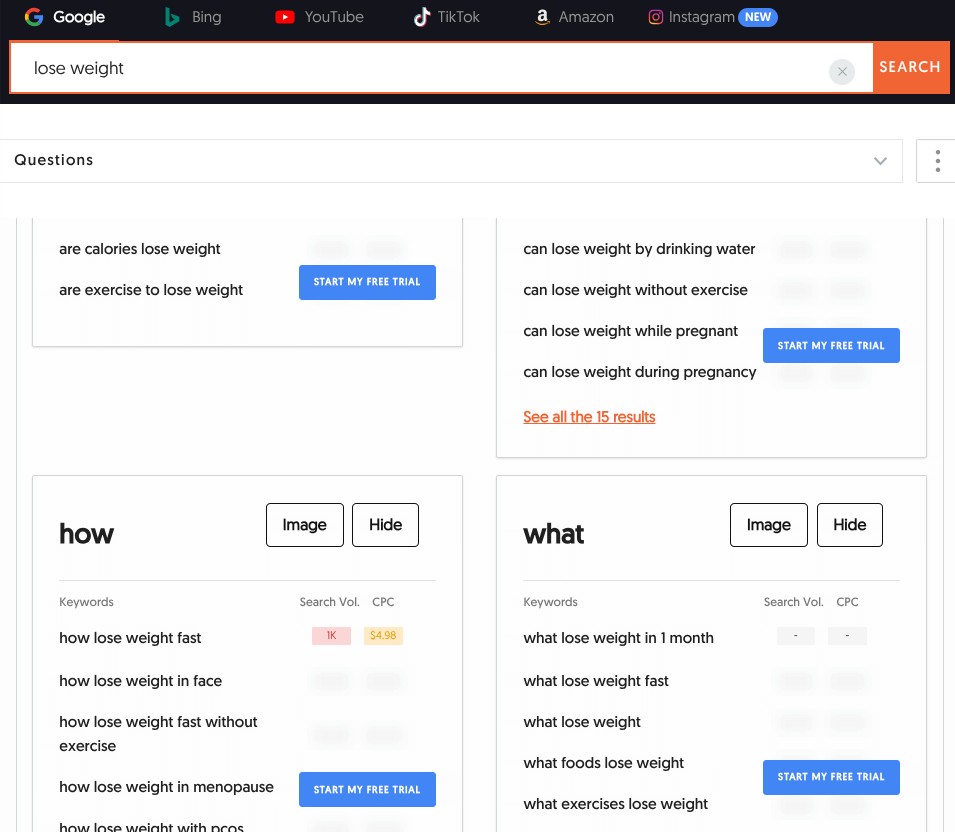
Speed Up the Process with AI
Instead of spending hours manually searching for this data, you can use AI to generate a full audience profile in seconds.
AI isn’t perfect but can save you hours of research time, unearth insights you might have missed, and help you work smarter.
But to get the best results, you need to know how to guide it effectively.
The better your prompt, the better the AI’s response.
That’s where the RABCD Framework comes in. This simple method helps you craft powerful, clear, and actionable prompts that generate high-quality insights.
Here’s a step-by-step walkthrough of how to use the RABCD Framework to structure your problem-solving prompts.
R – Role:
- Define who should respond to the prompt.
- Example: “You are a fitness expert specializing in training busy professionals.”
A – Action:
- Specify what you want the AI to do.
- Example: “Analyze the biggest challenges faced by busy professionals in maintaining a fitness routine.”
B – Background:
- Provide context for better relevance.
- Example: “The target audience is men aged 25-35 with limited time due to demanding careers.”
C – Constraints:
- Set limitations or requirements for precision.
- Example: “Only use real user quotes from Amazon reviews, Reddit, and fitness forums.”
D – Desired Output:
- Clearly state how the response should be formatted.
- Example: “Provide 5 direct user quotes with sources that highlight pain points and frustrations.”
AI-Powered Audience Research Prompt:
“You are an expert in consumer research specializing in fitness. I am launching an online fitness program targeting men aged 25-35 who are busy professionals with limited time for workouts. Please analyze my potential audience and provide a structured breakdown including:
- Demographics (age, gender, lifestyle)
- Fitness goals and challenges
- Motivations for working out
- What programs or solutions they’ve tried before
- Biggest obstacles stopping them from reaching their goals
- Preferred workout styles (HIIT, yoga, strength training, pilates, etc.)
- Where they consume fitness content (YouTube, Instagram, TikTok, podcasts, fitness blogs)
- Psychological triggers that influence buying decisions
- Any untapped opportunities in this niche.”
Here’s what this sample persona would look like:
Demographics:
- Age: 25-35 years old.
- Gender: Male.
- Lifestyle: Busy professionals often balance demanding careers, personal commitments, and social activities, leading to limited time for extensive workout routines.
Fitness Goals and Challenges:
- Goals:
- Weight Management: Maintaining a healthy weight amidst sedentary work environments.
- Muscle Development: Building or maintaining muscle mass for aesthetic and health reasons.
- Stress Reduction: Utilizing exercise as a means to manage stress and improve mental well-being.
- Challenges:
- Time Constraints: Limited availability for lengthy workout sessions due to professional and personal obligations.
- Consistency: Difficulty maintaining regular exercise routines amidst unpredictable schedules.
- Motivation: Struggling to stay motivated without structured programs or visible progress.
Motivations for Working Out:
- Health Concerns: Preventing lifestyle-related diseases and enhancing longevity.
- Physical Appearance: Improving physique to boost self-confidence and personal image.
- Performance Enhancement: Increasing energy levels and productivity in daily tasks.
Programs or Solutions Tried Before:
- Gym Memberships: Traditional gym settings offering various equipment and classes.
- Home Workouts: Utilizing online platforms or apps for convenience.
- Personal Training: Engaging with trainers for personalized guidance.
Biggest Obstacles Stopping Them from Reaching Their Goals:
- Time Management: Balancing work, personal life, and fitness commitments.
- Lack of Personalized Programs: Difficulty finding routines that cater to individual needs and limitations.
- Plateaus: Experiencing stagnation in progress leading to decreased motivation.
Preferred Workout Styles:
- High-Intensity Interval Training (HIIT): Efficient workouts that maximize calorie burn in shorter periods.
- Strength Training: Focusing on muscle building and metabolic health.
- Functional Fitness: Exercises that mimic daily activities to improve overall functionality.
Where They Consume Fitness Content:
- YouTube: Accessing free workout videos and fitness advice.
- Instagram: Following fitness influencers for tips and motivation.
- Podcasts: Listening to fitness and health discussions during commutes or work.
Psychological Triggers That Influence Buying Decisions:
- Convenience: Programs that fit seamlessly into their busy schedules.
- Personalization: Tailored workouts addressing individual goals and limitations.
- Community Support: Access to supportive communities or accountability groups.
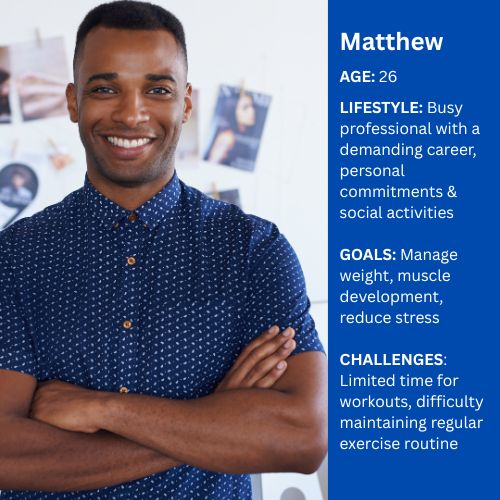
Get Real-life Quotes From Your Audience
Next, you want to gather quotes from real people. These help you create messaging that resonates with your audience.
Here’s an example prompt:
“Find real customer quotes from fitness product reviews (Amazon, Reddit, fitness forums), focusing on men aged 25-35 who are busy professionals. The quotes should highlight:
- Their biggest fitness challenges and frustrations (lack of time, consistency, motivation, progress plateaus, etc.).
- What they struggle with when using fitness programs or products.
- Their unmet needs and desires in fitness solutions (what they wish existed or worked better for them).
Prioritize reviews from people explicitly mentioning their busy schedules, professional careers, or struggles balancing fitness with work-life demands. Include source links.”
Here’s the output:
Understanding the challenges, needs, and desires of busy male professionals aged 25-35 is crucial when designing an online fitness program tailored to their lifestyle. Here are some insights gathered from individuals within this demographic, highlighting their experiences and perspectives:
Challenges and Pain Points:
Time Constraints and Motivation:
“Very few people are literally so busy that they can’t find time to workout 45-60 minutes at least 3 times per week. Aside from single parents, most don’t have good excuses. It’s about priorities.” (Reddit User)
“I have found that I can make a career trainer out of a good ‘people person’ with a hunger to learn how to train. The inverse simply hasn’t been the case outside of a couple of isolated incidents.” (StrongFirst User)
Needs and Desires:
Efficient and Flexible Workouts:
“It’s a very simple program with short, extremely simple workouts. As a result, it’s easy to be consistent and hard to skip a workout (hard to justify skipping a 20-minute workout you can do on any level surface).” (Reddit User)
Working Exercise into Daily Routine:
“Watching the 2nd season of Rick and Morty? Living room workout at the same time. Cooking dinner? Dance while you do it.” (Reddit User)
These insights show that your audience wants a fitness program that accommodates the busy schedules of professionals.
It also has to emphasize consistency and offer flexibility to integrate workouts into daily activities.
If you’re able to address these specific challenges and desires, your program can resonate with this target audience.
Day 2: Market Research – Analyze Your Competition
Before you can sell personal training online or any program, you need to understand who you’re up against. Competitive research helps you see what’s working, what’s missing, and how you can position yourself more effectively.
The Manual Approach to Competitive Research
If you were doing this manually, you’d:
- Google search for online fitness programs for men aged 25-35.
- Identify competitors offering similar programs.
- Build a simple spreadsheet with:
- Company Name
- Domain Name
- What They Offer (workout styles, features, bonuses)
- Pricing Model (one-time, subscription, tiered)
- What Makes Their Offer Compelling (unique selling points, testimonials, guarantees)
This method works, but it’s time-consuming—especially when trying to uncover pricing, customer sentiment, and offer differentiators.
That’s where AI comes in. With the right prompt, you can quickly extract structured insights from various sources, saving you hours of research.
Competitive Research Prompt Using RABCD:
“You are a market research expert specializing in fitness programs. Analyze the top competitors selling online fitness programs for busy professionals (men aged 25-35). Gather insights on:
1. The names of competing programs and who is selling them.
2. Their pricing models (one-time, subscription, tiered).
3. The key features of their programs (workout styles, length, level of personalization, bonuses).
4. Their unique selling points (what makes them stand out).
5. Any common themes in customer reviews or feedback.
Present the findings in a structured format. Include sources where possible.”
Here’s what AI found:
Competitor 1: F45 Training
- Company: F45 Training
- Website: f45training.com
- Pricing Model: Varies by location; typically subscription-based with options for class packages.
- Key Features:
- High-Intensity Interval Training (HIIT) sessions lasting 45 minutes.
- Combines functional movements with circuit training.
- Offers a supportive community environment.
- Unique Selling Points:
- Efficient workouts designed for maximum calorie burn in minimal time.
- Global presence with consistent training standards.
- Customer Feedback:
- Users appreciate the structured, time-efficient workouts that fit into busy schedules.
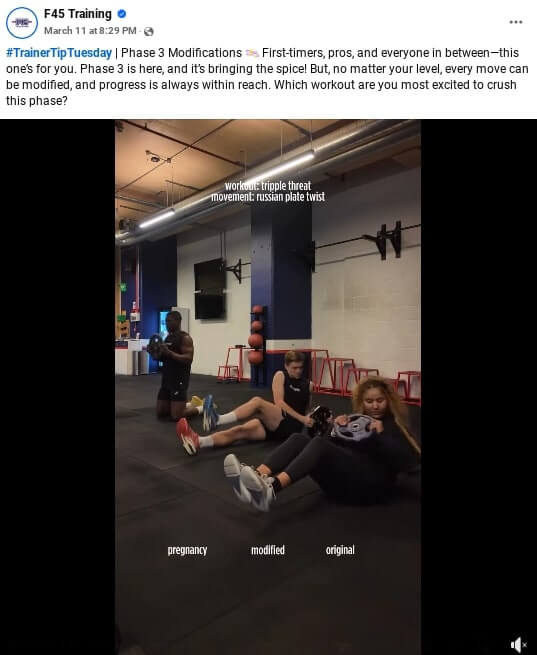
Competitor 2: BODi (formerly Beachbody On Demand)
- Company: Beachbody
- Website: beachbodyondemand.com
- Pricing Model: Subscription-based; approximately $99/year.
- Key Features:
- Diverse workout programs including P90X, Insanity, and 21 Day Fix.
- Access to nutrition guides and meal plans.
- Programs range from beginner to advanced levels.
- Unique Selling Points:
- Comprehensive fitness and nutrition solutions.
- High-quality production and well-known trainers.
- Customer Feedback:
- Users value the variety of programs and the convenience of at-home workouts.
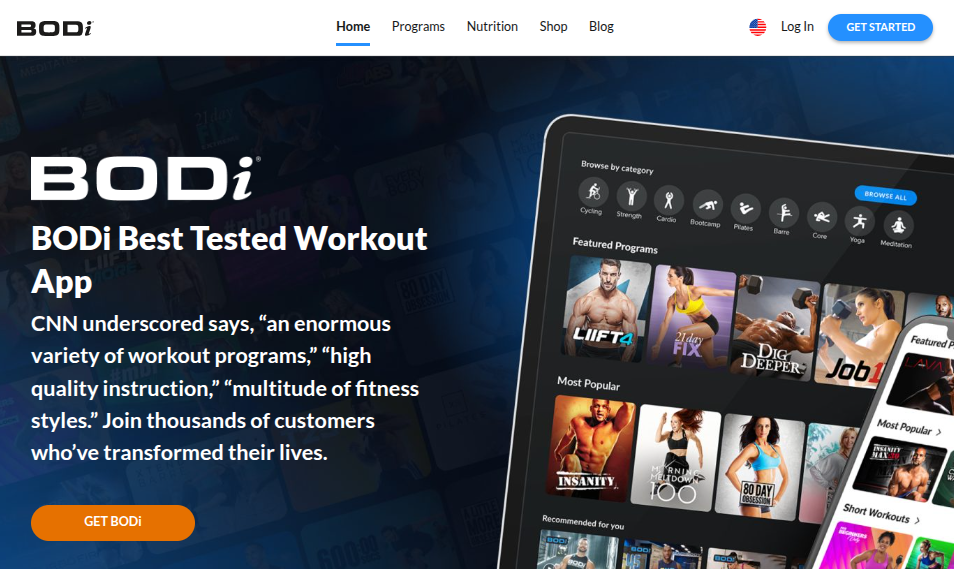
Competitor 3: Future Fitness
- Company: Future
- Website: future.co
- Pricing Model: Subscription-based; approximately $150/month.
- Key Features:
- One-on-one coaching with personalized workout plans.
- Regular check-ins and adjustments based on progress.
- Integration with Apple Watch for real-time feedback.
- Unique Selling Points:
- Combines personal training with the convenience of an app.
- High level of accountability and customization.
- Customer Feedback:
- Users report increased motivation and consistency due to personalized coaching.
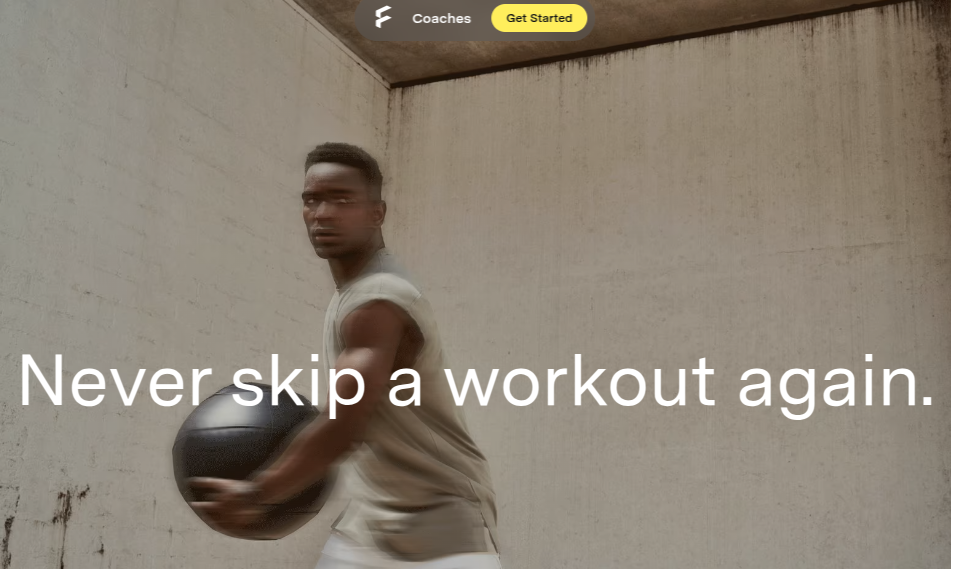
Competitor 4: Daily Burn
- Company: Daily Burn
- Website: dailyburn.com
- Pricing Model: Subscription-based; starting at $14.95/month.
- Key Features:
- New daily workouts catering to various fitness levels.
- Access to a library of diverse workout programs.
- Community support and tracking features.
- Unique Selling Points:
- Fresh content daily to keep users engaged.
- Flexibility to choose workouts based on mood and goals.
- Customer Feedback:
- Appreciated for its variety and the motivation provided by daily new content.
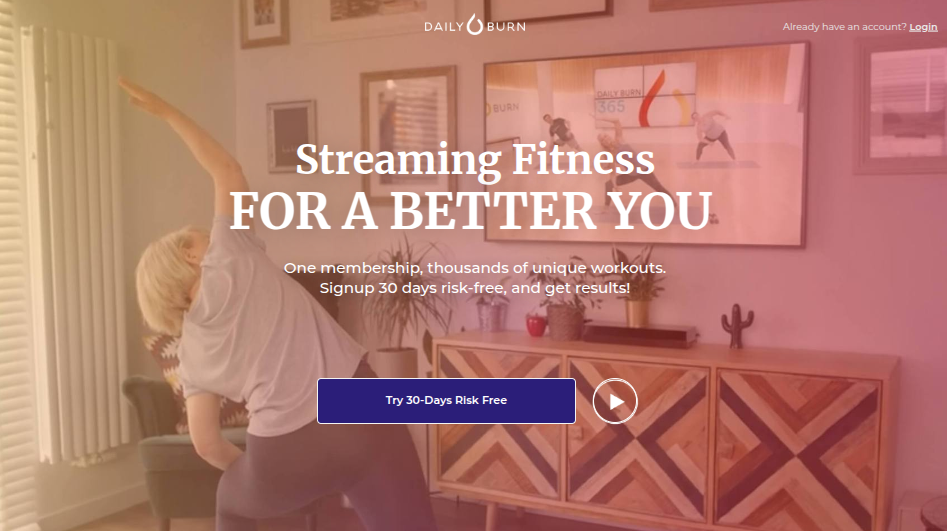
Common Themes in Customer Feedback:
- Flexibility: Programs that accommodate busy schedules are highly valued.
- Variety: Access to diverse workout options keeps users engaged.
- Personalization: Customized plans and coaching enhance motivation and results.
- Community Support: A supportive community or coaching element boosts accountability.
Day 3: Building Your Offer & Choose Your Business Model
Now that you’ve analyzed your audience and researched your competition, it’s time to craft an irresistible offer.
Your offer isn’t just about what you’re selling. It’s about how you position it in a way that makes it stand out, feel valuable, and get people to say yes without hesitation.
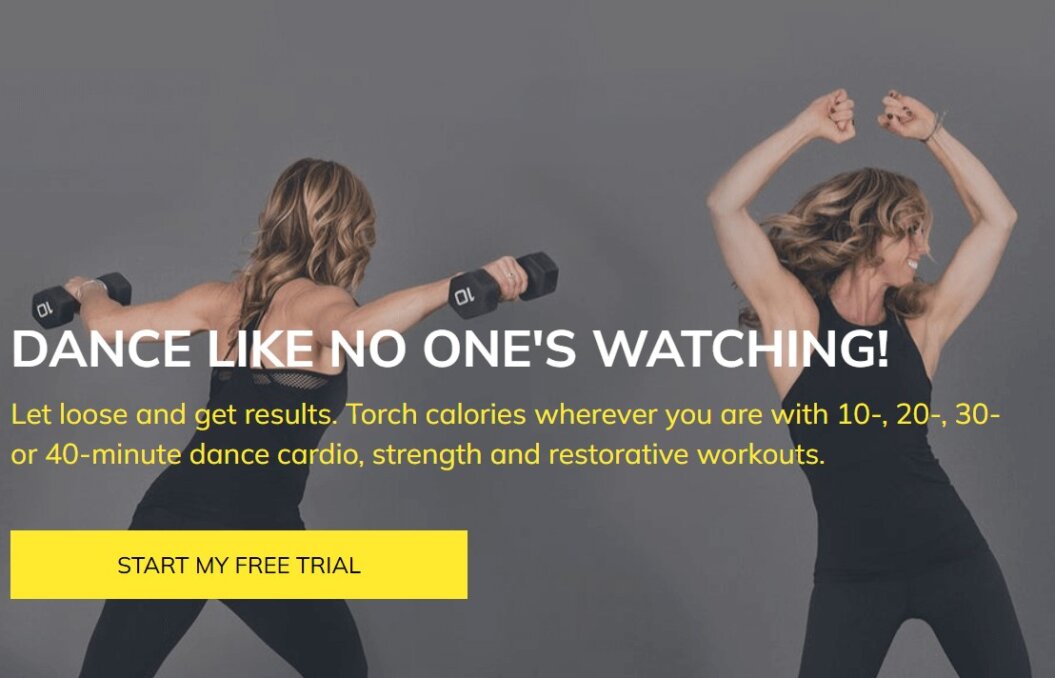
This requires:
- Finding your unique positioning – How does your program solve a problem better than the competition?
- Clarifying exactly what people get – No vague promises—clear, tangible benefits that help people see the transformation they’ll experience.
- Establishing the right price point – Competitive, compelling, and aligned with the value you’re providing.
When you package your program the right way, you don’t have to convince people to buy. They’ll see the value for themselves. Your offer is so compelling, it’s a no-brainer.
Let’s explore how to do that.
Manual vs. AI-Powered Gap Analysis
If you’ve been conducting your research manually, you should now have a solid dataset—including insights on competitors, pricing models, and customer needs.
At this stage, your goal is to identify any gaps in the market and determine how your program can offer something different or better.
You can complete this stage manually, or use AI to speed things up.
If you’d rather save time, you can upload all of your research data into ChatGPT. With a simple prompt, it can help you:
- Identify gaps in the market that your program can fill.
- Position your offer strategically so it stands out.
- Determine the right price point based on competitor pricing and perceived value.
- Refine your program details to make it as compelling as possible.
Here’s what your AI-analysis prompt could look like:
“You are a fitness market strategist specializing in online programs. I am launching a fitness program for busy professionals (men aged 25-35) who struggle with time, consistency, and motivation. I need your help to position my offer strategically.
Here’s what I need you to analyze:
1. Market Gaps: Based on common themes in competitor offerings, what are the biggest unmet needs and gaps in existing programs? What are fitness consumers still struggling with?
2. Strategic Positioning: How can I differentiate my program to stand out? What messaging, features, or benefits will make my offer unique and irresistible?
3. Best Price Point: What is the ideal pricing model for my audience (one-time fee, subscription, or tiered pricing)? Justify the price based on competitor data and perceived value.
4. Compelling Offer Structure: What should I include in my program to maximize its appeal? Suggest high-value bonuses, customization options, accountability structures, or additional perks that will make it a no-brainer for my audience.
Use insights from consumer behavior, psychology, and competitor analysis to craft a powerful, unique, and high-converting fitness program offer. Present the findings in a structured format with clear action steps.”
Here’s how AI did:
1. Market Gaps:
- Time Constraints: Many existing programs require significant time commitments, which can be challenging for busy professionals.
- Consistency and Motivation: Users often struggle with maintaining regular workout routines due to lack of motivation and accountability.
- Personalization: Generic workout plans may not address individual fitness levels, preferences, or specific goals, leading to disengagement.
2. Strategic Positioning:
- Efficient Workouts: Design short, effective workout sessions (e.g., 20-30 minutes) that can fit into tight schedules.
- Personalized Plans: Offer tailored workout and nutrition plans based on individual assessments to meet specific goals and preferences.
- Accountability Mechanisms: Integrate features like progress tracking, regular check-ins, and community support to enhance motivation and consistency.
3. Best Price Points:
Tiered Pricing Model: Provide multiple pricing tiers to accommodate different budgets and desired levels of service:
- Basic Tier: Access to standard workout plans and community forums at an affordable rate.
- Premium Tier: Includes personalized coaching, advanced tracking features, and exclusive content at a higher price point.
This approach allows users to choose services that best fit their needs and financial situations.
4. Compelling Offer Structure:
- Flexible Scheduling: Provide on-demand workouts that users can access anytime, accommodating varying schedules.
- Comprehensive Resources: Include nutrition guides, mental wellness resources, and lifestyle tips to support holistic health.
- Community Engagement: Foster a supportive community through forums, group challenges, and social features to enhance user engagement and accountability.
- Progressive Programs: Develop programs that evolve with the user’s fitness level, offering new challenges to prevent plateaus and maintain interest.
You’ve just found a gap in the market that will help you create an attractive product for your audience.
Next, let’s choose a business model.
Choosing the Right Business Model
When selling fitness programs online, your business model determines how you generate revenue and scale your offer.
If you’re selling fitness programs online, creating video content is the smartest way to go, and here’s why:
1. Unlimited Scalability & Passive Income
Unlike in-person training, video lets you serve unlimited clients and generate recurring revenue without trading time for money. Once created, your content keeps selling, creating a sustainable, scalable business model.
2. Higher Engagement & Better Results
Video keeps users engaged, motivated, and on track by allowing them to see, follow, and mirror movements in real time. It’s far more effective than written guides, leading to better form, faster progress, and higher retention.
3. Global Reach & Brand Growth
Video breaks geographic limits, letting you reach a global audience and attract clients beyond your local market.

There are three main video content models that work for fitness businesses.
1. Ad-Supported Video on Demand (AVOD) – Free Content With Ad Revenue
AVOD relies on free content monetized through ads—one of the most common models seen on platforms like YouTube.
AVOD is best suited for fitness influencers who want to build an audience first and monetize later.
You create free fitness content such as workout videos, tips, and challenges to attract an audience.
Instead of charging for access, you earn revenue through ad placements, such as YouTube’s AdSense program.
This model is great for brand awareness and driving traffic to your fitness brand, and it has a low barrier to entry since users don’t have to pay upfront.
However, revenue can be inconsistent and depends heavily on ad views. To make a significant income, you need a high volume of traffic, which can take time to build.
2. Transactional Video on Demand (TVOD) – One-Time Purchases
TVOD is a pay-per-download or pay-per-view model. Customers make a one-time payment to access specific content, such as a structured 30-day fitness challenge or an advanced workout series.
It’s best for fitness entrepreneurs who want to launch one-time digital products such as workout guides or structured fitness challenges.
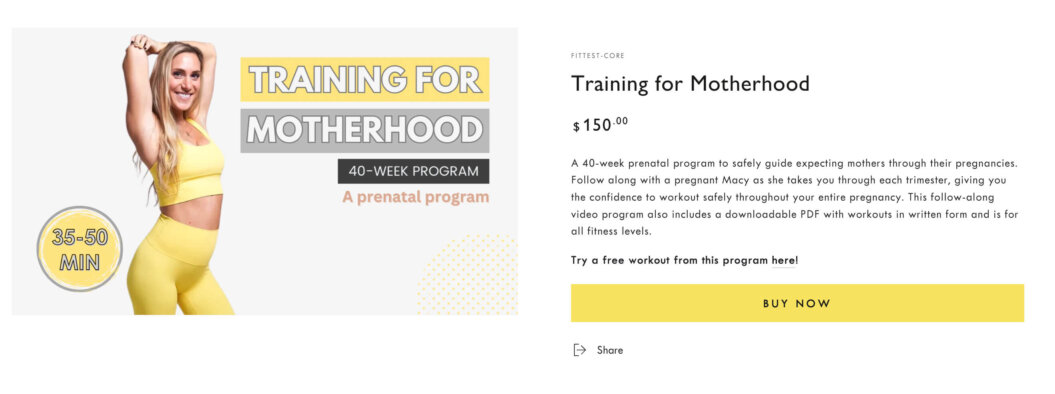
A key advantage of TVOD is that it provides immediate sales revenue without requiring ongoing commitment from users.
You also have complete flexibility over your pricing. However, because sales are one-time transactions, there is no recurring revenue.
It becomes harder to predict income. You’ll have to constantly attract new customers to maintain profitability.
3. Subscription Video on Demand (SVOD) – Best for Recurring Income
SVOD is one of the most reliable and scalable models for online fitness programs. It is membership-based.
Users pay a recurring fee—monthly, quarterly, or annually—to access your fitness content, coaching, and exclusive community features.
If you want to create a sustainable, predictable, and recurring income that can scale over time, this model is for you.
Because of its scalability, once your content is created, additional subscribers do not significantly increase your costs.
SVOD also fosters stronger community engagement because members feel part of an exclusive fitness group with ongoing value.
SVOD does require consistent content creation to keep members engaged. Unlike one-time purchases, where users pay upfront and leave, subscribers expect regular updates, new challenges, and interaction.
Find What Feels Good uses this model and has over 4,600 active members.
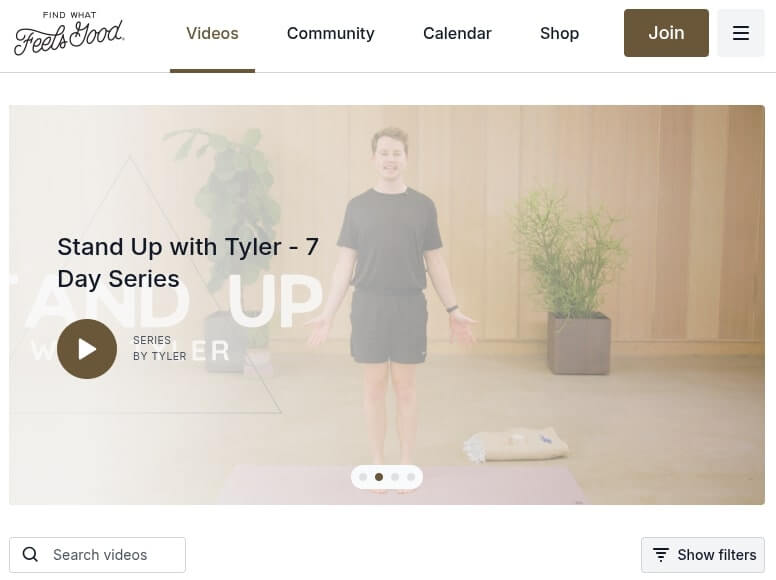
Read their story here.
Day 4: Building Your Sales Machine
Now that you’ve created your content, it’s time to set up the foundation of your sales machine.
This involves creating essential pages, organizing your content, and setting up memberships. And on Day Five, I’ll share how you’ll get paid effortlessly.
But first, you’ll need a domain name for your new business.
1. Buy a Domain Name
There are many domain name registrars, each with its own order and checkout processes. Buying a domain name is straightforward, and should take no more than five minutes.
💡IMPORTANT: If you’re going to use a video content platform like Uscreen, your website and content will be hosted with your video content platform. Do NOT buy hosting when buying your domain name.
Domain registrars worth visiting for the lowest prices include:
With your new domain name in hand, you’ll be able to connect it to your video content platform and set up your website.
2. Create Your Essential Website Pages
Your website should have a clear structure that guides visitors toward signing up for your program. Here are the key pages you need:
Homepage – This is the first impression of your program. It should clearly state who your program is for, what results they can expect, and how to get started. Include strong visuals, testimonials, and a call to action to join.
Jazzercise On Demand has a clear value proposition front and center.
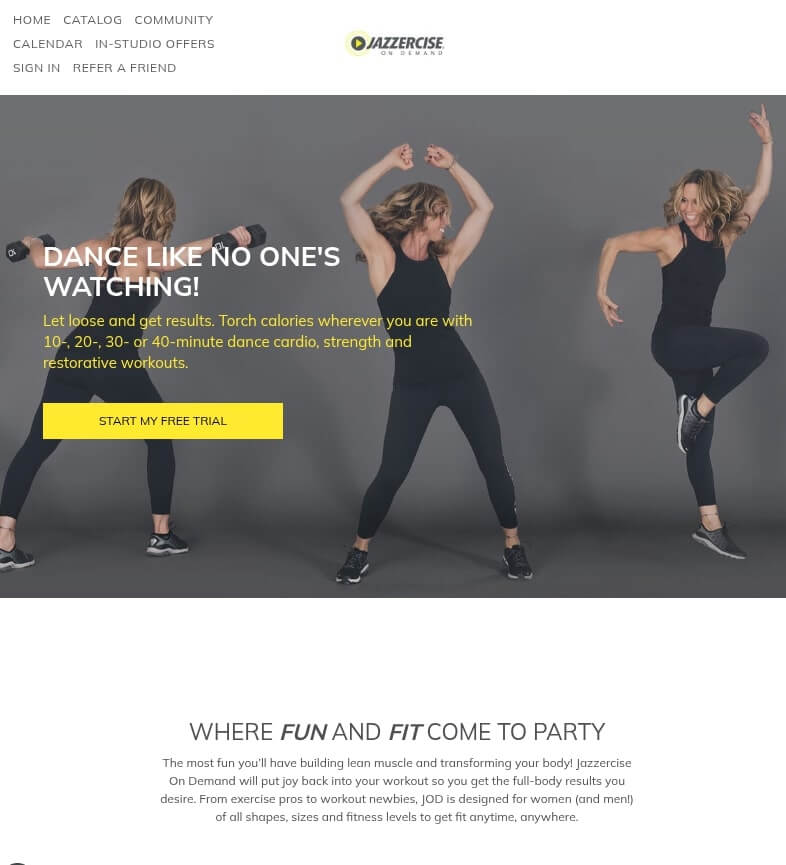
About Page – Tell your story, why you created this program, and what makes it different. Build trust by sharing your experience and expertise.
John Garey’s About page speaks about his values and how Pilates shaped him.
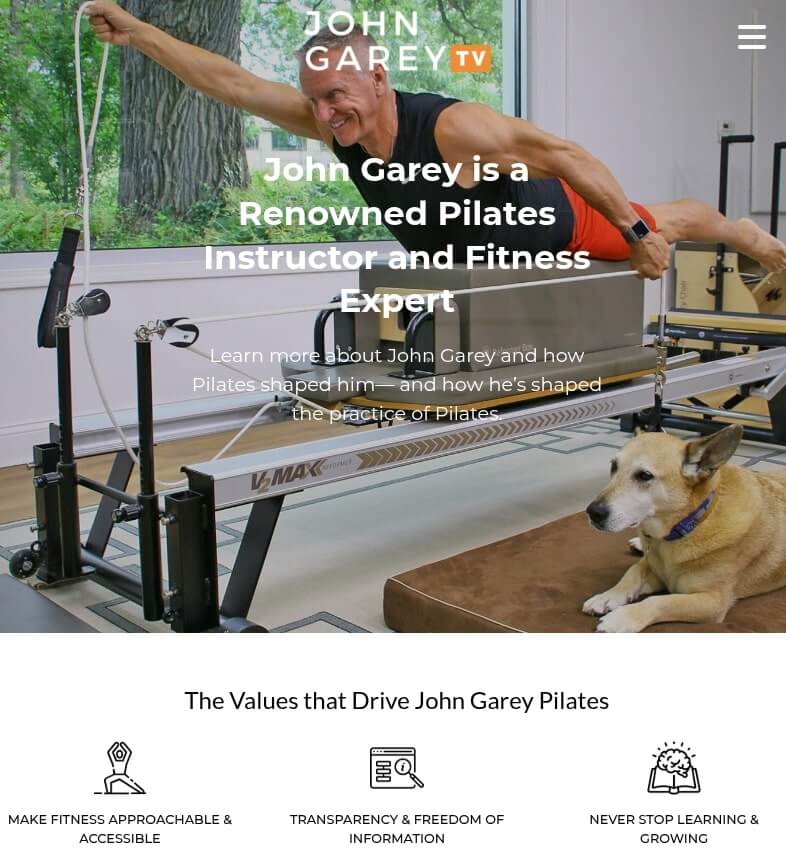
Program Page – Break down what’s included in your fitness program. List the workout types, duration, membership perks, and any bonuses like meal plans or coaching. This page should answer every possible question a potential buyer might have.
Mom’s Into Fitness shares all its programs with short descriptions to help website visitors find what best suits them.
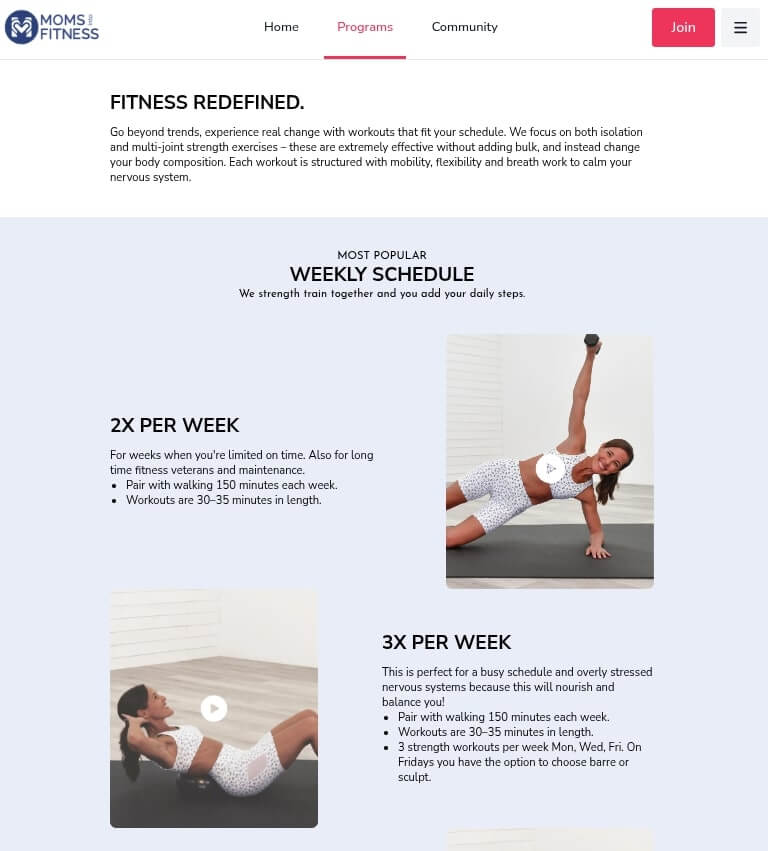
Pricing Page – Clearly outline membership tiers, benefits, and pricing. Offer multiple options if applicable (monthly, annual, premium tiers). Highlight any free trials or money-back guarantees.
Body Fit By Amy shows three membership plans.
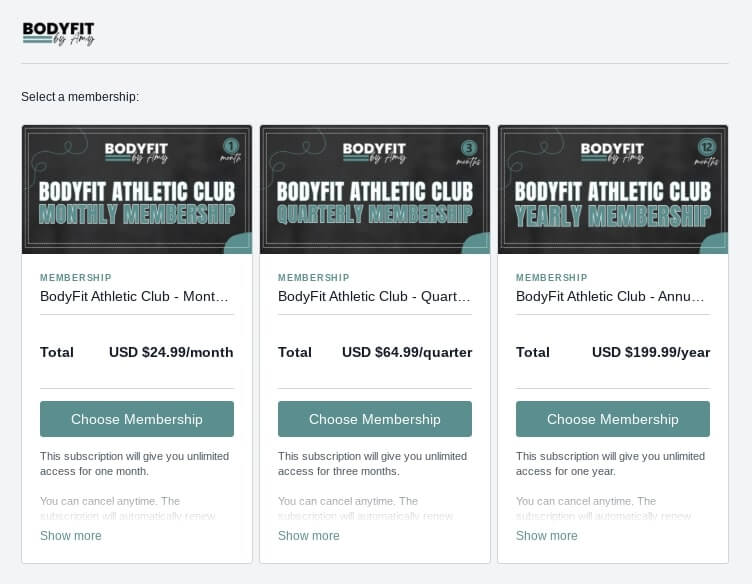
FAQ Page – Address common concerns about the program, billing, cancellations, and what makes your program unique.
While you can create a page dedicated to testimonials, you can also sprinkle them throughout your website, like Kula.
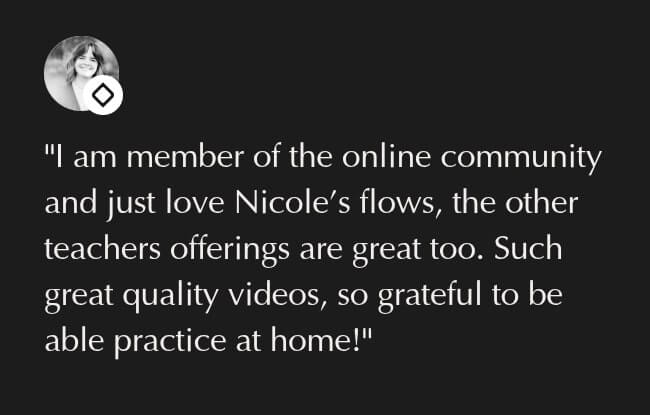
3. Upload & Categorize Your Content
Once your pages are set up, upload your workout videos, guides, and resources to your content library. Organize your materials into clear categories so users can easily navigate and find the right workouts.
- Beginner Workouts – For users just starting out or getting back into fitness.
- Intermediate Workouts – For those who have experience and want to level up.
- Advanced Workouts – High-intensity or specialized programs for experienced users.
- Additional Resources – Nutrition guides, mobility routines, stretching plans, and any downloadable PDFs that complement your program.
4. Set Up Your Membership Tiers
Decide on your membership structure and what each tier includes. Common memberships include:
- Basic Membership – Access to core workouts and community features at an affordable price.
- Premium Membership – Includes personalized coaching, advanced tracking, exclusive content, or live Q&A sessions.
- Annual Membership – Offers the best value with a discounted yearly price.
Make sure your pricing is clearly displayed on your website and that each tier communicates its value effectively.
Day 5: Connect Your Payment Gateway
To start accepting payments, you’ll need to sign up for and integrate a secure and seamless payment processor.
Uscreen supports multiple payment gateways, like Stripe, PayPal, and Authorize.net.
With Uscreen’s built-in security features, all payment data is encrypted and protected, so you don’t have to worry about handling sensitive financial information.
Payments are also processed automatically, so you can focus on growing your fitness business while Uscreen ensures everything runs smoothly in the background.
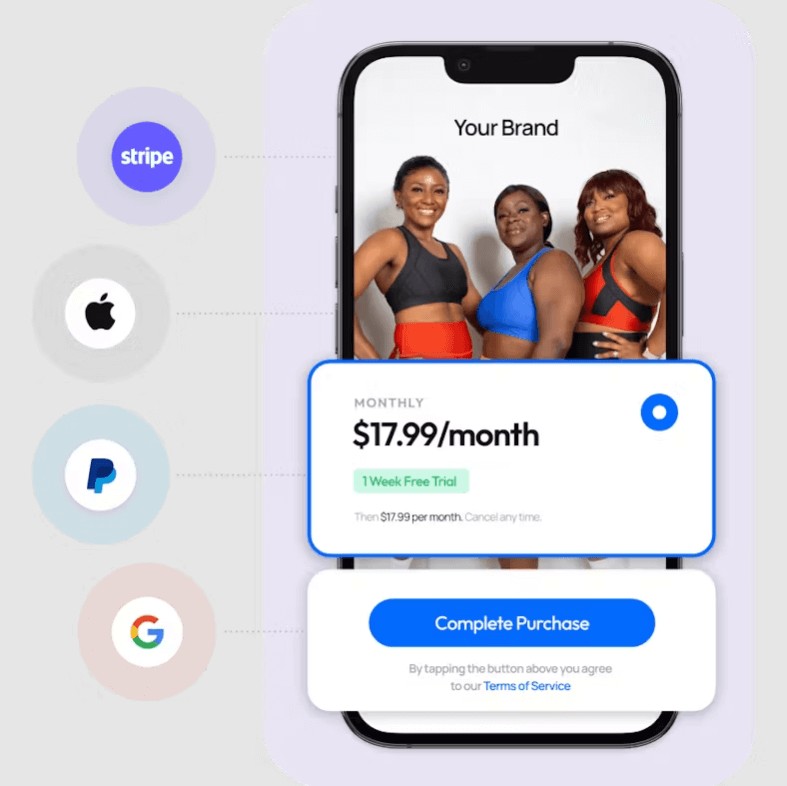
Create Your Apps
Expanding your fitness business with a white-labeled app enhances your brand’s reach and provides your audience with seamless access to your content.
Uscreen simplifies this process, enabling you to launch customized apps without extensive technical expertise.
Success Story: How The Bloom Method Generates $1m in Annual Revenue Using Apps
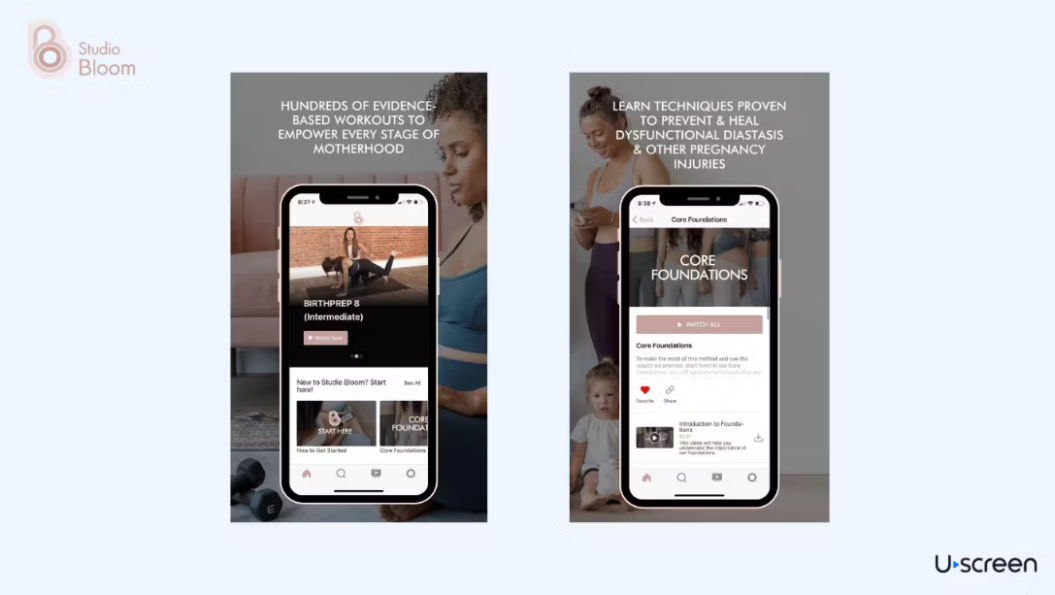
Brooke Cates, founder of The Bloom Method, creates a fitness brand specializing in prenatal and postnatal workouts. She leveraged Uscreen’s app development services to significant success. By launching their own branded app, they achieved:
- Over 5,100 paying subscribers
- 76% watch time in the past six months
- Over $1 million in annual revenue
Brooke also had this to say about her experience starting out as a fitness content creator and growing her business:
We were a bootstrap company leading with a passion that we wanted to put out in the world. And there was so much trial and error. We went from one camera to two cameras, boom mics to actual mics. I mean, it’s just do it like just put it out there because as you grow, you can always kind of like perfect the experience that you want people to have.
Types of Apps Available with Uscreen
- Mobile Apps: Deliver your content directly to users’ smartphones and tablets, compatible with both iOS and Android platforms.
- TV Apps: Extend your reach to living rooms by offering apps for Apple TV, Roku, Amazon Fire TV, and Android TV.
Uscreen Apps Features
- Custom Branding: Maintain your brand identity with fully customizable app interfaces.
- Offline Viewing: Allow users to download content for offline access, enhancing flexibility.
- In-App Purchases: Monetize efficiently with support for subscriptions and one-time purchases directly within the app.
- Push Notifications: Engage your audience with updates on new content, promotions, or events.
Our apps are a big hit with Uscreen customers. Marnie Alton, founder of M/BODY, loves that her global audience can watch her videos offline:
One of the things you can do that’s really great on the app is you can work out offline. That’s a really big fave and fun thing because again, we have such a global and diverse community where Wi-Fi isn’t always the greatest for them, where they live or where they’re at, or they’re taking us on a vacation or on a road trip.
Marnie Alton | Founder of M/BODY
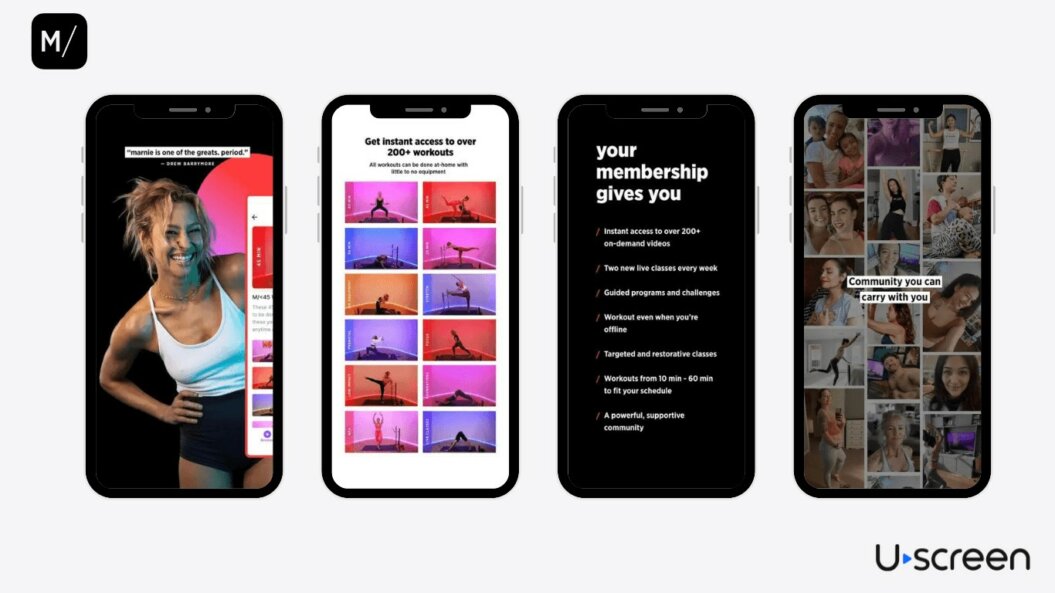
Uscreen’s Comprehensive Support
Uscreen manages the technical aspects of app development, including design, submission, and maintenance, allowing you to focus on creating valuable content.
Launching your own fitness apps really couldn’t be any easier.
Steps to Launch Your App with Uscreen
- Prepare Your Content: Ensure your videos and resources are uploaded and organized within the Uscreen platform.
- Customize Your App: Utilize Uscreen’s tools to design your app’s appearance, aligning it with your brand aesthetics.
- Submit for Approval: Uscreen handles the submission process to various app stores, streamlining approvals.
- Launch and Promote: Once approved, your app is live and ready for your audience to download and enjoy.
If you’d like to launch apps, Uscreen offers the App Essentials plan at $499 per month. It includes the development of two mobile apps. Learn more here.
Day 6: Promoting Your Fitness Program
Once your fitness program is set up, the next step is getting it in front of the right audience.
There are two ways to promote your fitness programs: paid advertising for immediate visibility and organic marketing for long-term audience building.
Paid Advertising – The Fastest Way to Get In Front of Your Target Audience
There are many ad platforms you can use. Google Ads and Microsoft Ads are search-based platforms. They differ from Facebook and Instagram (Meta Ads), and TikTok which allow you to target specific demographics, meaning your ads will be shown to people who match your ideal customer profile.
With paid ads on Facebook, Instagram, and TikTok, you can:
- Showcase your offer instantly to thousands of potential customers.
- Use precise targeting (age, gender, interests, behaviors) to ensure your ads reach the right audience.
- Drive traffic directly to your sales page, lead magnet, or app.
To make your ads effective, use compelling visuals, clear messaging, and a strong call-to-action (CTA), such as:
- “Start Your 7-Day Free Trial Today!”
- “Get Fit in Just 30 Minutes a Day—Join Now!”
If you have a limited budget, start small. You can launch your first ad campaign on Facebook or Instagram with a $5-a-day budget. The same applies to Google Ads and Microsoft Ads.
See what works, test different ads, and scale up based on what performs best.
Here’s an example of ads F75 Training is running on Facebook to get your creative juices going:

💡TIP: Want to know what your competition is advertising? Head over to their Facebook page, click on the About tab, and check to see if they are running ads. If they are, click on the “See all” button.
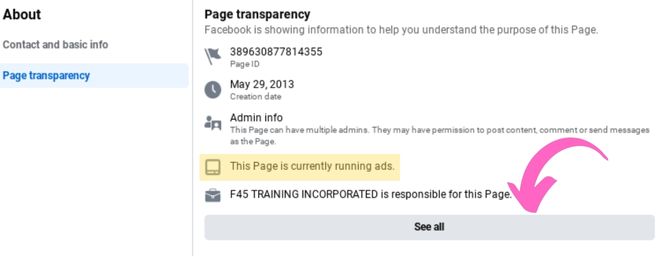
To get started with Meta Ads, I recommend learning how to use the platform. You can do this for free by completing a free online training with Facebook.
It’s called Meta Blueprint and covers all you need to know about creating and launching ads.
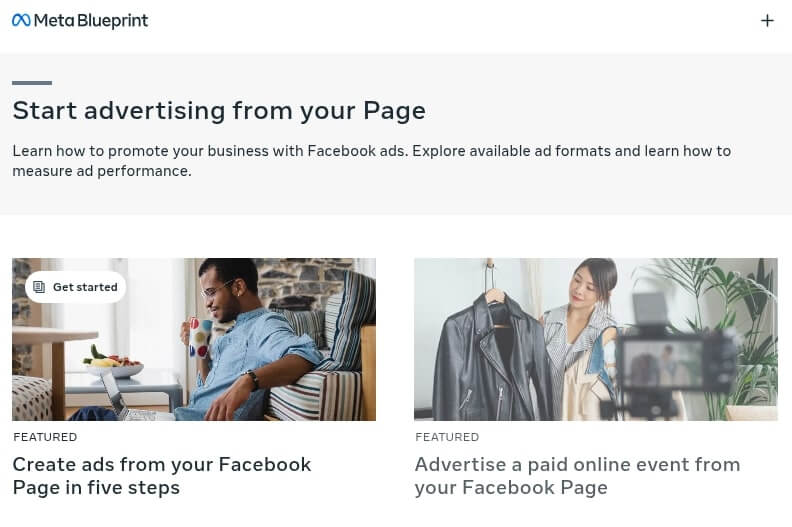
Organic Marketing – Building a Brand and Loyal Audience Over Time
While paid ads offer instant traffic, organic marketing helps establish your brand, build trust, and create long-term engagement.
Though it takes more time, a strong organic presence allows you to attract and retain customers without spending money on ads.
Types of Content to Grow Your Audience
The best way to build an audience organically is by creating valuable, engaging content. Here are some high-performing content types with examples:
- Short-Form Video (TikTok, Instagram Reels, YouTube Shorts) – Quick workout tips, transformations, behind-the-scenes clips.
- Long-Form Video (YouTube, IGTV, Facebook) – Full-length workouts, expert advice, Q&As.
- Social Media Posts (Instagram, Facebook, Twitter) – Motivational posts, fitness myths, client success stories.
- Blog Articles (SEO-friendly content on your website) – “Best Workouts for Busy Professionals,” “How to Stay Fit with a 9-to-5 Job.”
- Email Marketing – Weekly newsletters with fitness tips, program updates, and exclusive offers.
This is an organic content example from F45 Training. It’s part of a tip series and features video.
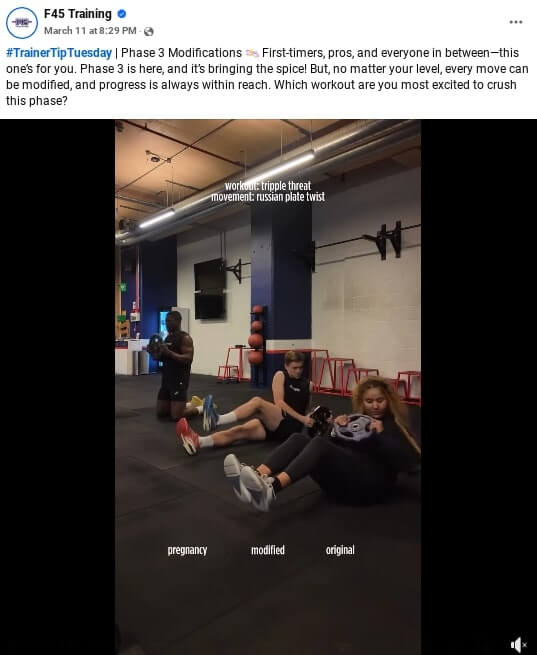
Channel Followers from Social Media to Your Website
To convert followers into paying members, you need to move them from social media to your website.
The best way to do this is by offering free, valuable content in exchange for their email. This is where a lead magnet comes in.
Use a Lead Magnet to Capture Leads
A lead magnet is a free resource that entices potential customers to share their email addresses.
You can then nurture subscribers through email marketing and convert them into paying members over time.
Examples of effective lead magnets include:
- 7-Day Free Trial – Let people experience your program risk-free.
- Free Workout Plan – “30-Minute Fat-Burning Workout for Busy Professionals.”
- Meal Prep Guide – “Easy, Healthy Meals for a Busy Lifestyle.”
Mom’s Into Fitness offers a free 7-day trial where they capture an email address.
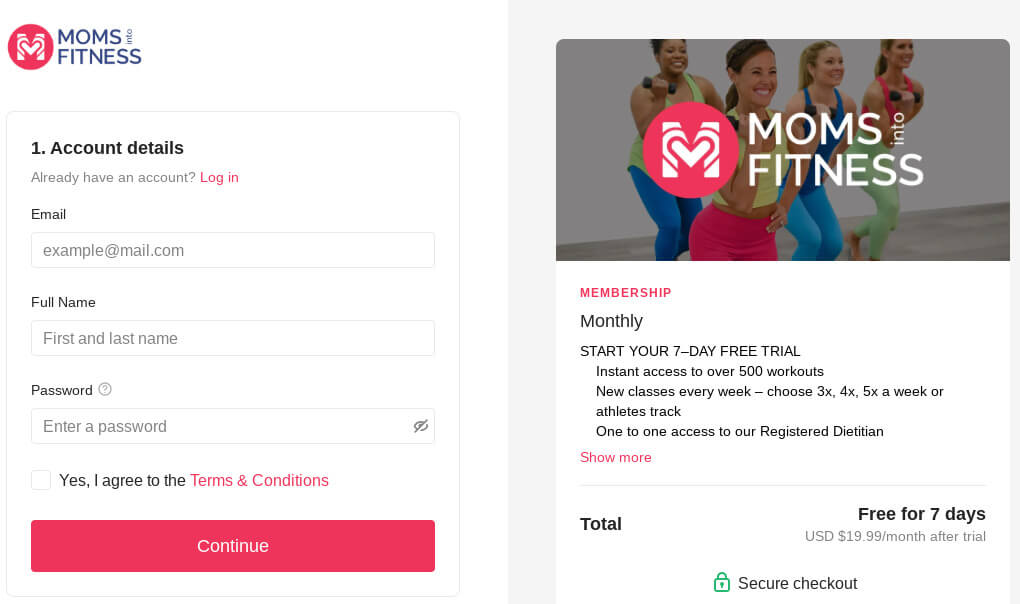
Once a website visitor’s signed up, send a welcome email sequence introducing them to your program and encouraging them to subscribe.
What a 7-Day Welcome Email Sequence Looks Like
Here’s an example of a 7-day email marketing sequence designed to engage, nurture, and convert leads who signed up for your 7-day free trial of your fitness program.
The goal is to get them hooked on the workouts, reinforce the value of your program, and encourage them to become paying members before the trial ends.
Day 1: Welcome to Your 7-Day Free Trial – Here’s How to Get the Most Out of It!
- Goal: Get them excited, set expectations, and guide them toward their first workout.
- Content:
- Welcome them enthusiastically and congratulate them on starting their fitness journey.
- Provide clear instructions on how to access the program.
- Suggest a specific workout to start with.
- Offer a quick win (e.g., “Try this 10-minute workout today and feel the difference!”).
For example, here’s what the welcome email from Pilates For Runners looks like:
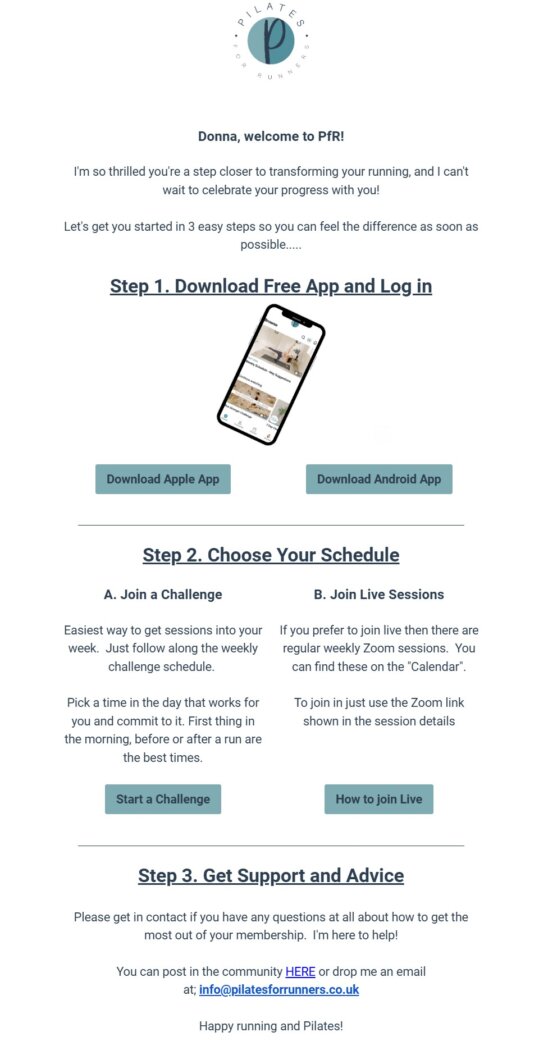
Day 2: Your Body is Going to Thank You – Keep the Momentum Going!
- Goal: Reinforce commitment and help them build a habit.
- Content:
- Acknowledge the challenge of starting something new.
- Encourage them to stay consistent and remind them of their goal.
- Share a motivational story or testimonial from someone who started just like them.
- Include a workout challenge for today.
Day 3: The Secret to Seeing Results Faster (Hint: It’s Not Just About Exercise)
- Goal: Introduce the importance of nutrition and recovery to maximize results.
- Content:
- Provide a simple nutrition or recovery tip that complements their workouts.
- Suggest a pre/post-workout meal idea for energy and muscle recovery.
- Link to a bonus resource, such as a meal guide or stretching routine.
- Encourage them to keep going and remind them of their progress so far.
Day 4: What’s Your Biggest Challenge? Let’s Overcome It Together.
- Goal: Address potential roadblocks and build a sense of support and community.
- Content:
- Ask them to reply and share their biggest challenge so far.
- Offer quick solutions for common struggles (lack of time, motivation, soreness).
- Reinforce that they’re not alone and you’re here to help.
- Remind them to check out today’s workout.
Day 5: Only 2 Days Left! Ready to Keep This Going?
- Goal: Start planting the seed for conversion.
- Content:
- Remind them that their free trial ends in two days.
- Highlight the benefits of continuing with the program after the trial.
- Offer an exclusive incentive (e.g., “Get 10% off your first month if you sign up today!”).
- Share a before-and-after story from a paying member.
Day 6: What Happens After Your Free Trial Ends? (Don’t Miss This!)
- Goal: Make it easy for them to transition into a paid membership.
- Content:
- Recap everything they’ve gained during the trial.
- Show them what comes next if they continue (new workouts, exclusive content, community perks).
- Remind them that the special offer from Day 5 expires soon.
- Include a direct link to subscribe.
Day 7: Last Chance! Your Free Trial Ends Tonight!
- Goal: Create urgency and drive last-minute conversions.
- Content:
- Make it clear that today is the final day of their free trial.
- Reiterate the value of staying in the program.
- Remind them of the exclusive bonus or discount that expires soon.
- Use a strong CTA: “Click here to continue your fitness journey now!”
The Best Promotion Strategy: Combine Paid & Organic
Combining both approaches gives you the best chance at success. You’ll attract, engage, and convert more customers, setting up your fitness program for long-term growth.
- Use paid ads to generate quick sales and drive traffic to your program.
- Grow an organic audience through consistent, high-quality content that builds your brand.
- Capture leads with a lead magnet and nurture them through email marketing.
Day 7 Onwards: Track & Optimize for Growth
Once your fitness program is live, tracking and optimizing your business performance is crucial for long-term success.
By monitoring key metrics, you’ll know what’s working, what’s not, and where to focus your efforts to grow your revenue and audience.
Key Areas to Track:
- Sales & Revenue: Keep an eye on monthly subscriptions, one-time purchases, and overall revenue trends.
- Subscriber Retention: Monitor how long members stay subscribed and identify patterns in cancellations.
- Engagement: Track how often users watch your content, which workouts are most popular, and where drop-offs occur.
- Marketing Performance: Measure the effectiveness of your paid ads, social media campaigns, and lead magnets to optimize conversions.
Uscreen’s Built-In Tracking & Reporting Tools
Uscreen provides powerful analytics and reporting tools to help you track business performance without needing third-party solutions.
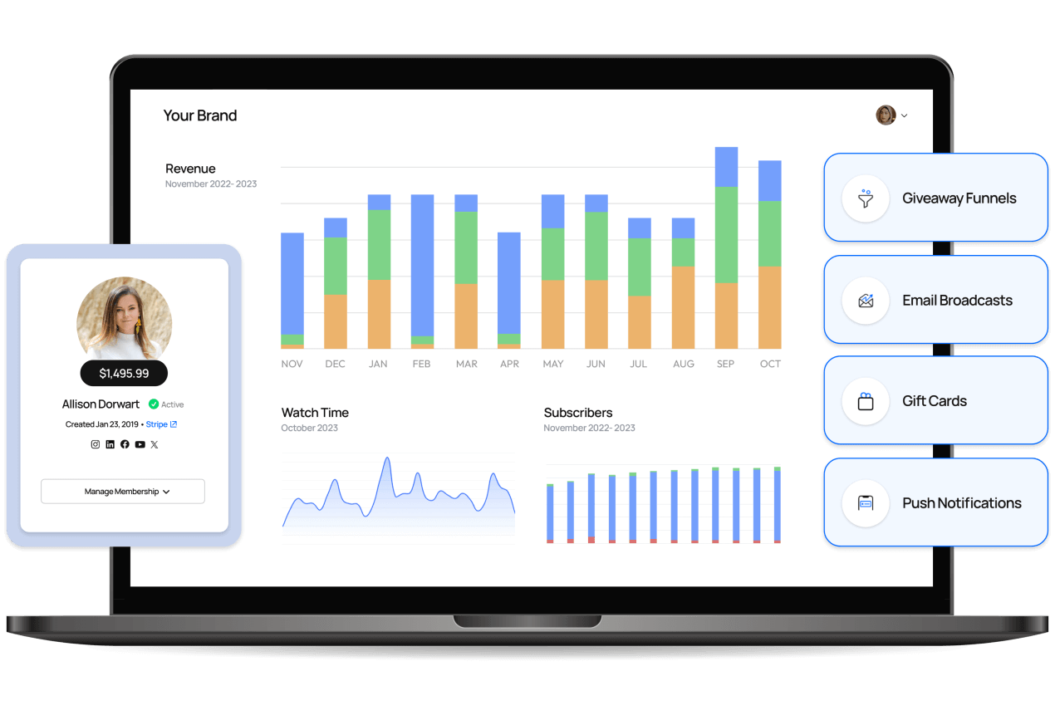
You can track:
- Sales & Revenue Reports: Get real-time insights on purchases, subscription trends, and revenue growth.
- Engagement Analytics: See which videos are performing best, how long users watch, and where they disengage.
- Marketing & Subscriber Insights: Monitor conversion rates, churn, and retention to adjust your marketing strategies.
How to Use This Data to Optimize Your Business
- Identify Top-Performing Content – Double down on the workouts, courses, and challenges that get the most views and engagement.
- Improve Member Retention – If people are canceling after a certain period, introduce new content, exclusive perks, or personalized outreach to keep them subscribed.
- Optimize Marketing Efforts – If ads aren’t converting, test new creatives, different audience segments, or stronger calls-to-action.
- Adjust Pricing or Offers – If sign-ups are slow, experiment with limited-time promotions, bundled offers, or pricing adjustments.
Tracking and optimizing your business may not seem exciting at first, but it’s the engine that drives long-term growth.
The ability to make small, strategic adjustments can lead to massive results.
Over time, you may find that this daily routine isn’t just essential. It becomes one of the most rewarding parts of building a thriving fitness business.
The Final Rep
And that’s how you sell fitness programs online!
Let’s not sugarcoat it—selling fitness programs online takes work. But when you know exactly what to do and why, it becomes a straightforward process.
This guide has everything you need to go from an idea to a fully launched fitness business.
The best way to tackle this is to break it up into manageable steps. To help, here’s a short recap of how to turn this guide into a 7-day project:
Day 1: Market Research – Figure Out Your Audience
- Identify your ideal customer and their pain points.
Day 2: Market Research – Analyze Your Competition
- Research competitors and find gaps in the market.
Day 3: Build Your Offer & Choose Your Business Model
- Craft a unique positioning for your fitness program.
- Decide between AVOD (ad-supported), TVOD (one-time purchases), or SVOD (subscriptions).
- Choose the model that aligns with your business goals.
Day 4: Build Your Sales Machine
- Set up your website and essential pages (Home, About, Pricing, Program Details, FAQ).
- Organize your content library into beginner, intermediate, and advanced categories.
- Structure your membership tiers and pricing.
Day 5: Set Up Payments & Memberships & Create & Launch Your Apps
- Integrate payment gateways for smooth transactions.
- Set up your white-labeled mobile and TV apps with Uscreen.
- Customize your branding and submit it for approval.
Day 6: Promote Your Program
- Run paid ads on Facebook, Instagram, and TikTok to reach your ideal audience fast.
- Create organic content (short-form videos, blog posts, social media updates) to build a long-term audience.
- Offer a lead magnet (free trial, guide, or challenge) to capture emails and nurture leads.
Day 7 Onwards: Track & Optimize for Growth
- Use analytics to track revenue, subscriber retention, and engagement.
- Identify which workouts and content are driving the most value.
- Adjust your marketing, pricing, and content strategy based on real data.
- Focus on keeping members engaged to reduce churn and maximize recurring revenue.
Selling fitness programs online is more within reach than ever before.
With the right strategy, platform, and consistent optimization, you can build a profitable, scalable fitness business that grows over time.
The only thing left to do?
Get started.






